Mechanism of Nitrogen Removal from Aqueous Solutions Using Natural Scoria
Abstract
:1. Introduction
2. Materials and Methods
2.1. Materials
2.2. Characterization of Scoria
2.3. Static Adsorption Experiments
2.4. Interaction between Scoria and Nitrogen
2.4.1. Physical Action
2.4.1.1. Van der Waals Force
2.4.1.2. Electrostatic Force
2.4.2. Chemical Action
2.4.2.1. Ion Exchange Function
2.4.2.2. Functional Groups
2.5. Influencing Factors of Common Ions
3. Results and Discussion
3.1. Removal Efficiency
3.2. Characterization of Scoria
3.3. Interaction between Scoria and Nitrogen
3.3.1. Physical Action
3.3.1.1. Van der Waals Force
3.3.1.2. Electrostatic Force
3.3.2. Chemical Action
3.3.2.1. Ion Exchange Function
3.3.2.2. Functional Groups Analysis
3.4. Effect of Interfering Ions
4. Conclusions
Acknowledgments
Author Contributions
Conflicts of Interest
References
- Ghose, M.K. Complete physico-chemical treatment for coke plant effluents. Water Res. 2002, 36, 1127. [Google Scholar] [CrossRef]
- Hallberg, G.R. Agricultural chemicals in groundwater: Extent and implications. Am. J. Altern. Agric. 1987, 2, 3–15. [Google Scholar] [CrossRef]
- Jiang, Z.; Ning, P.; Pu, H.P.; Deng, C.L.; Huang, X.F. Research on removing ammonia-nitrogen from water by activated zeolite. J. Saf. Environ. 2004, 4, 40–43. [Google Scholar]
- Ji, Z.Y.; Yuan, J.S.; Li, X.G. Removal of ammonium from wastewater using calcium form clinoptilolite. J. Hazard. Mater. 2007, 141, 483–488. [Google Scholar] [CrossRef] [PubMed]
- Hu, Z.; Lotti, T.; Loosdrecht, M.V.; Kartal, B. Nitrogen removal with the anaerobic ammonium oxidation process. Biot. Lett. 2013, 35, 1145–1154. [Google Scholar] [CrossRef] [PubMed]
- Gregory, S.P.; Dyson, P.J.; Fletcher, D.; Gatland, P.; Shields, R.J. Nitrogen removal and changes to microbial communities in model flood/drain and submerged biofilters treating aquaculture wastewater. Aquacult. Eng. 2012, 50, 37–45. [Google Scholar] [CrossRef]
- Wen, T.; Zhang, X.; Zhang, H.Q.; Liu, J.D. Ammonium removal from aqueous solutions by zeotile adsorption together with chemical precipitation. Water Sci. Technol. 2010, 61, 1941–1947. [Google Scholar] [CrossRef] [PubMed]
- Xu, J.; Pu, Y.; Qi, W.K.; Yang, X.; Tang, Y.; Wan, P.; Fisher, A. Chemical removal of nitrate from water by aluminum-iron alloys. Chemosphere 2017, 166, 197–202. [Google Scholar] [CrossRef] [PubMed]
- Aiyuk, S.; Xu, H.; Van, H.A.; Verstraete, W. Removal of ammonium nitrogen from pretreated domestic sewage using a natural ion exchanger. Environ. Technol. 2004, 25, 1321–1330. [Google Scholar] [CrossRef] [PubMed]
- Yang, Y.Z. Improvement and optimization of permeable reactive barrier technology to remove ammonium from groundwater. China Univ. Geosci. 2013, 1, 1–7. [Google Scholar]
- Wang, X.L. Study on in-situ microbial remediation of nitrate contaminated groundwater simulator. Anhui Hefei Univ. Technol. 2010, 1, 7–13. [Google Scholar]
- Sarioglu, M. Removal ammonium from municipal wastewater using natural Turkish (Dogantepe) zeolite. Sep. Purif. Technol. 2005, 41, 1–11. [Google Scholar] [CrossRef]
- Yu, Y.; Zhuang, Y.Y.; Wang, Z.H. Adsorption of water-soluble dye onto functionalized resin. J. Colloid Interface Sci. 2001, 242, 288–293. [Google Scholar] [CrossRef]
- Saltalı, K.; Sarı, A.; Aydın, M. Removal of ammonium ion from aqueous solution by natural Turkish (Yıldızeli) zeolite for environmental quality. J. Hazard. Mater. 2007, 141, 258–263. [Google Scholar] [CrossRef] [PubMed]
- Mizuta, K.; Matsumoto, T.; Hatate, Y.; Nishihara, K.; Nakanishi, T. Removal of nitrate-nitrogen from drinking water using bamboo powder charcoal. J. Bioresour. Technol. 2004, 95, 255–257. [Google Scholar] [CrossRef] [PubMed]
- Huang, H.; Xiao, X.; Bo, Y.; Yang, L. Ammonium removal from aqueous solutions by using natural Chinese (Chende) zeolite as adsorbent. J. Hazard. Mater. 2010, 175, 247–252. [Google Scholar] [CrossRef] [PubMed]
- Zhao, Y.; Niu, Y.; Hu, X.; Xi, B.; Peng, X.; Liu, W.; Guan, W.; Wang, L. Removal of ammonium ions from aqueous solutions using zeolite synthesized form red mud. Desalin. Water Treat. 2015, 57, 4720–4731. [Google Scholar]
- Haji, S.; Al-Buqaishi, B.A.; Bucheeri, A.A.; Bu-Ali, Q.; Al-Aseeri, M.; Ahmed, S. The dynamics and equilibrium of ammonium removal from aqueous by Na-Y zeolite. Desalin. Water Treat. 2015, 57, 18992–19001. [Google Scholar] [CrossRef]
- Zhang, L.Y.; Zhang, H.Y.; Guo, W.; Tian, Y.L. Sorption characteristics and mechanisms of ammonium by coal by-products: Slag, honeycomb-cinder and coal gangue. Int. J. Environ. Sci. Technol. 2013, 10, 1309–1318. [Google Scholar] [CrossRef]
- Zhu, Y.; Kolar, P.; Shah, S.B.; Cheng, J.J.; Lim, P.K. Avocado seed-derived activated carbon for mitigation of aqueous ammonium. Ind. Crops Prod. 2016, 92, 34–41. [Google Scholar] [CrossRef]
- Guaya, D.; Valderrama, C.; Farran, A.; Cortina, J.L. Modification of a natural zeolite with Fe(III) for simultaneous phosphate and ammonium removal from aqueous solutions. J. Chem. Technol. Biot. 2016, 91, 1737–1746. [Google Scholar] [CrossRef]
- Kwon, J.S.; Yun, S.T.; Kim, S.O.; Mayer, B.; Hutcheon, I. Sorption of Zn(II) in aqueous solutions by scoria. Chemosphere 2015, 60, 1416–1426. [Google Scholar] [CrossRef] [PubMed]
- Lee, M.G.; Lim, J.H.; Hyun, S.S.; Kam, S.K. Adsorption characteristics of copper ion by Jeju scoria. Hwahak Konghak 2002, 40, 252–258. [Google Scholar]
- Zhang, Y.L.; Zhang, S.Y.; Song, F.; Huang, J.Y.; Zhang, Y.; Bai, X.D. Utilization of scoria as PRB reactive media for the removal of petroleum hydrocarbon from groundwater. J. Adv. Mater. Res. 2012, 535–537, 2457–2461. [Google Scholar] [CrossRef]
- Zhang, S.Y.; Lu, Y.; Lin, X.Y.; Su, X.S.; Zhang, Y.L. Removal of fluoride from groundwater by adsorption onto La(III)-Al(III) loaded scoria adsorbent. J. Appl. Surf. Sci. 2014, 303, 1–5. [Google Scholar] [CrossRef]
- Zhang, Y.L.; Dong, T.Z.; Su, X.S.; Qian, H.; Wang, J.L. Effect of high fluoride groundwater purification by lightweigh. Environ. Earth Sci. 2016, 75, 10. [Google Scholar] [CrossRef]
- Uehara, G.; Gillman, G.P. Charge characteristics of soils with variable and permanent charge minerals: I. Theory. Soil Sci. Soc. Am. J. 1980, 44, 250–252. [Google Scholar] [CrossRef]
- Tie, Z.Y. Research on the removal of hardness from groundwater. Shandong Jianzhu Univ. 2013, 1, 1–4. [Google Scholar]
- Xie, B.H. Research on groundwater quality of large-scale irrigation—A case of Jinghuiqu irrigation district. Chang’an Univ. 2013, 1, 13–18. [Google Scholar]
- Feng, L.; Mai, W.; Wu, L. Test study on ammonia-nitrogen removal using activated zeolite. Henan Sci. 2006, 24, 294–295. [Google Scholar]
- Li, D.; Xie, H.; Li, B.; Wang, Q. Effects of ammonia nitrogen concentration on the selection of advanced treatment process with activated carbon. Chin. J. Environ. Eng. 2007, 1, 65–68. [Google Scholar]
- Li, R.; Li, J.; Wang, J. Zeolite activation and ammonia-nitrogen removal from wastewater by adsorption on activated zeolite. Acta Sci. Circumstantiae 2008, 28, 1618–1624. [Google Scholar]
- Xv, P. Physicochemical characterization and behavior of hydrotalcite-like compound toward nitrate removal. South China Univ. Technol. 2013, 1, 24–27. [Google Scholar]
- Li, B. Technology research of graphene supported nanometer iron removal of nitrate nitrogen in groundwater. Chang’an Univ. 2013, 1, 21–27. [Google Scholar]
- Yang, K.G.; Yuan, Y.M. Geology, 1st ed.; China University of Geosciences Press: Beijing, China, 2009; pp. 160–161. [Google Scholar]
- Amin, M.M.; Rahimi, A.; Bina, B. Performance evaluation of a scoria-compost biofilter treating xylene vapors. J. Environ. Health Sci. Eng. 2014, 12, 140. [Google Scholar] [CrossRef] [PubMed]
- Liao, P. Adsorption mechanism of nitrogen-heterocyclic compounds in wastewater on porous bamboo charcoal. Huazhong Univ. Sci. Technol. 2013, 1, 28–30. [Google Scholar]
- Cui, X.N. Studies on adsorption characteristics and mechanism of heavy metal ions from wastewater onto pretreated tea residue. Huazhong Agric. Univ. 2011, 1, 39–43. [Google Scholar]
- Sara, S.; Amir, R.A.; Mahdi, G.; Abbas, M. Usage of Iranian scoria for copper and cadmium removal from aqueous solutions. J. Cent. South Univ. 2015, 22, 3760–3769. [Google Scholar]

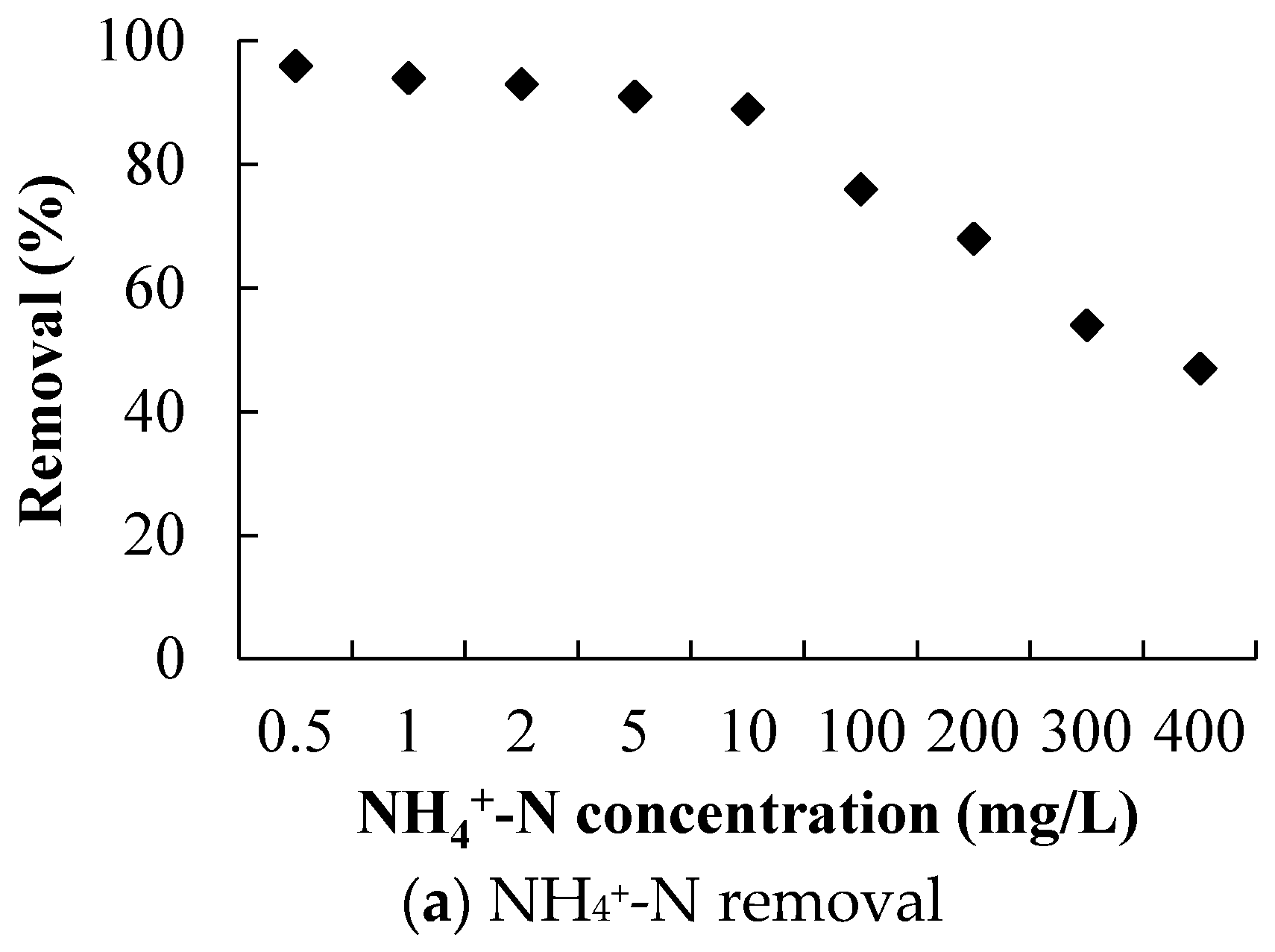
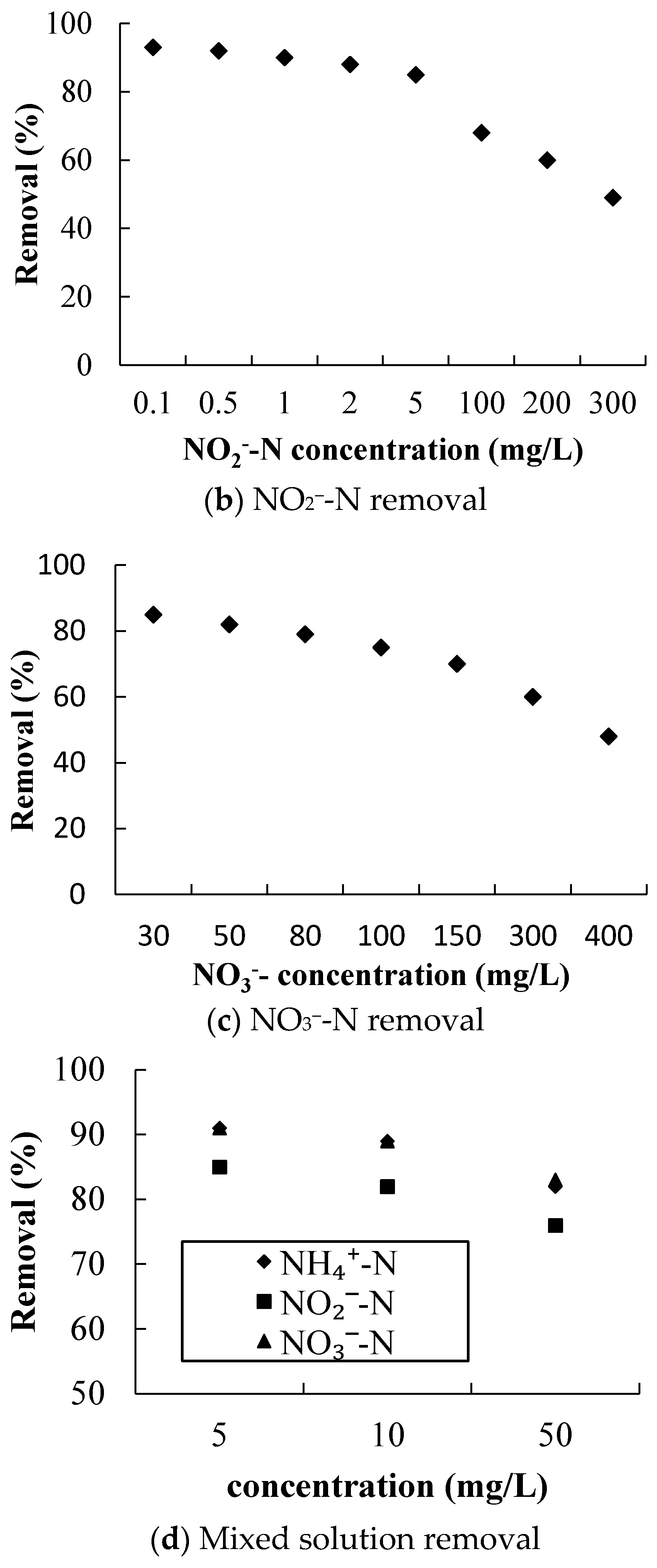

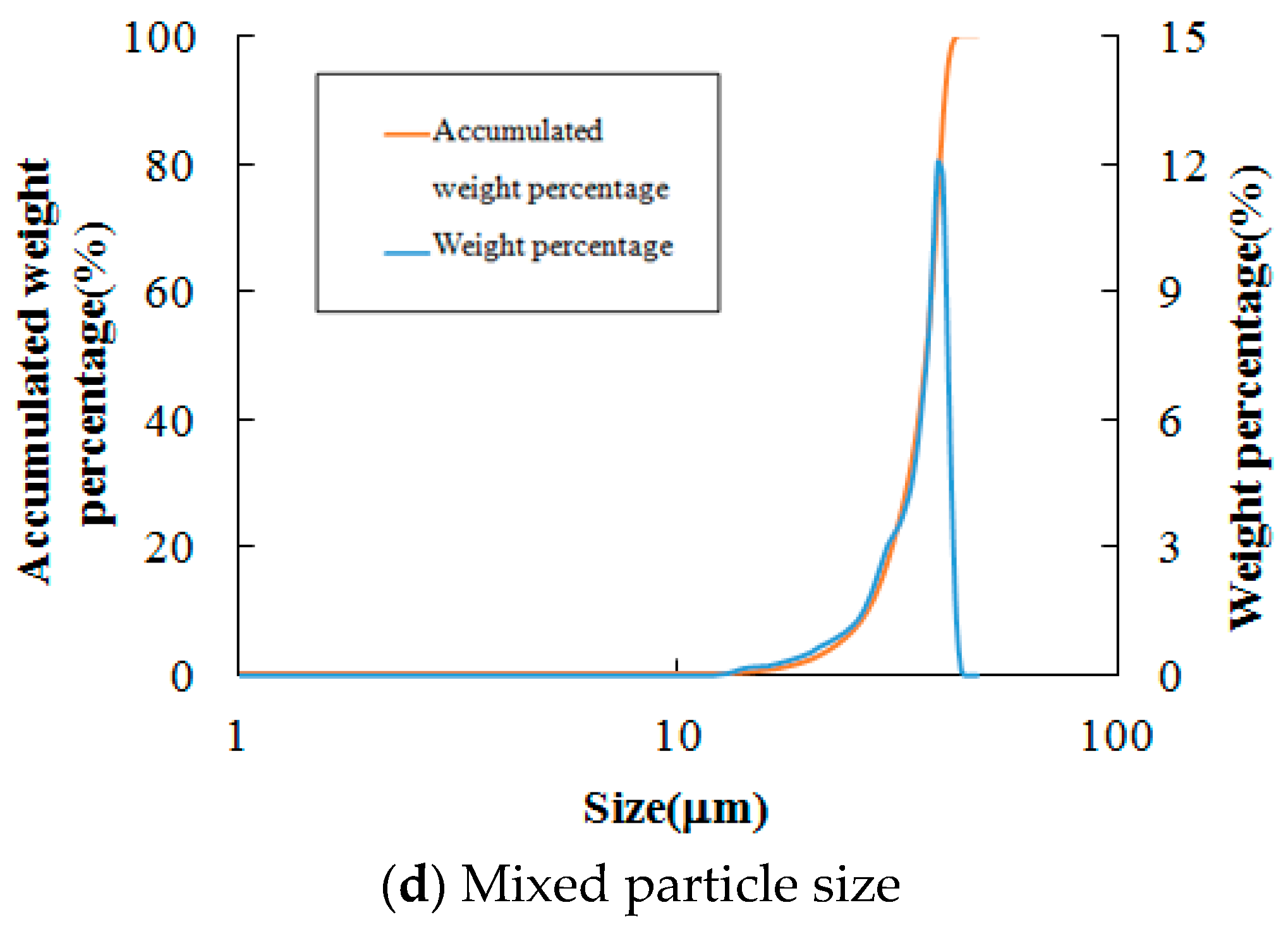
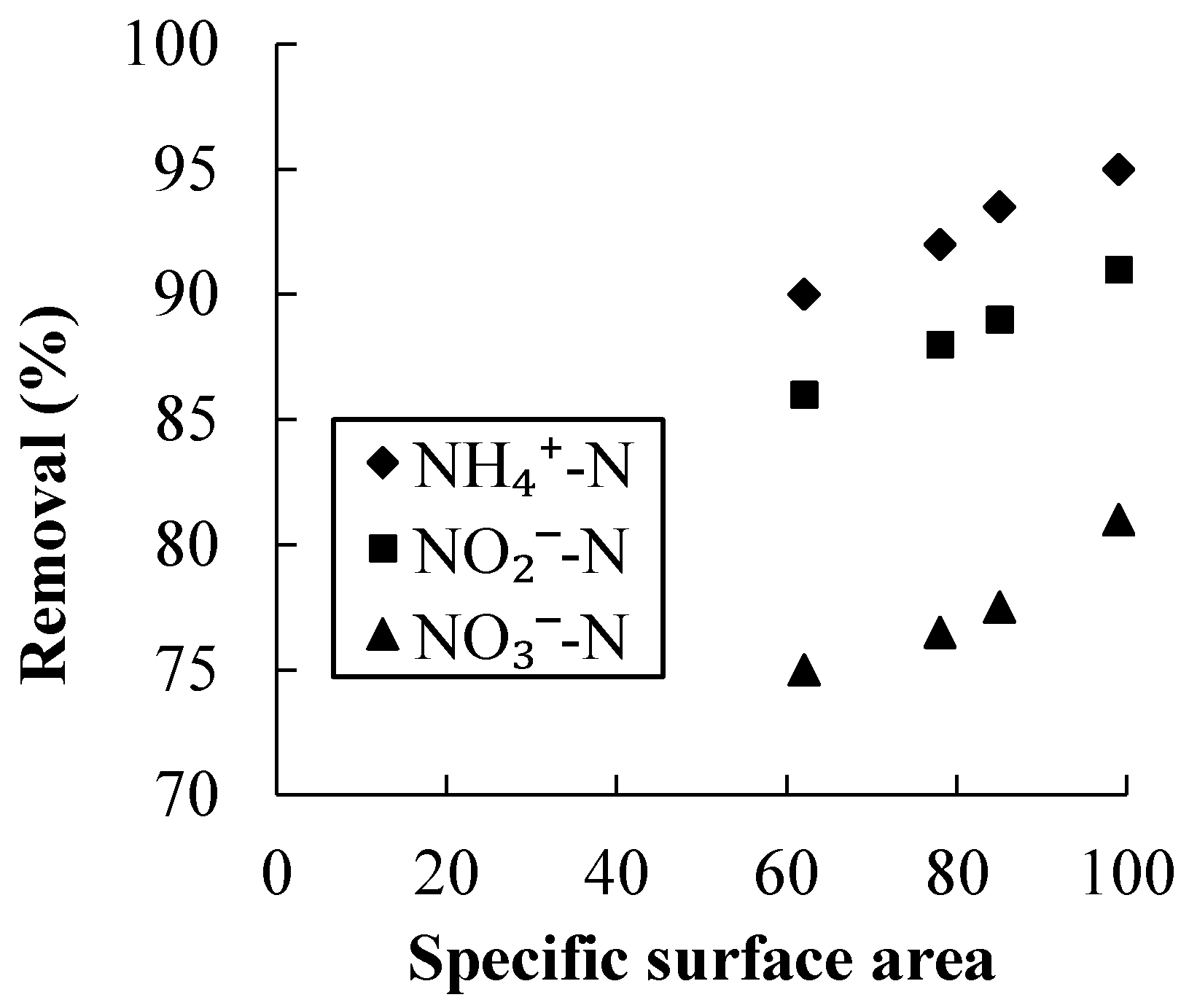
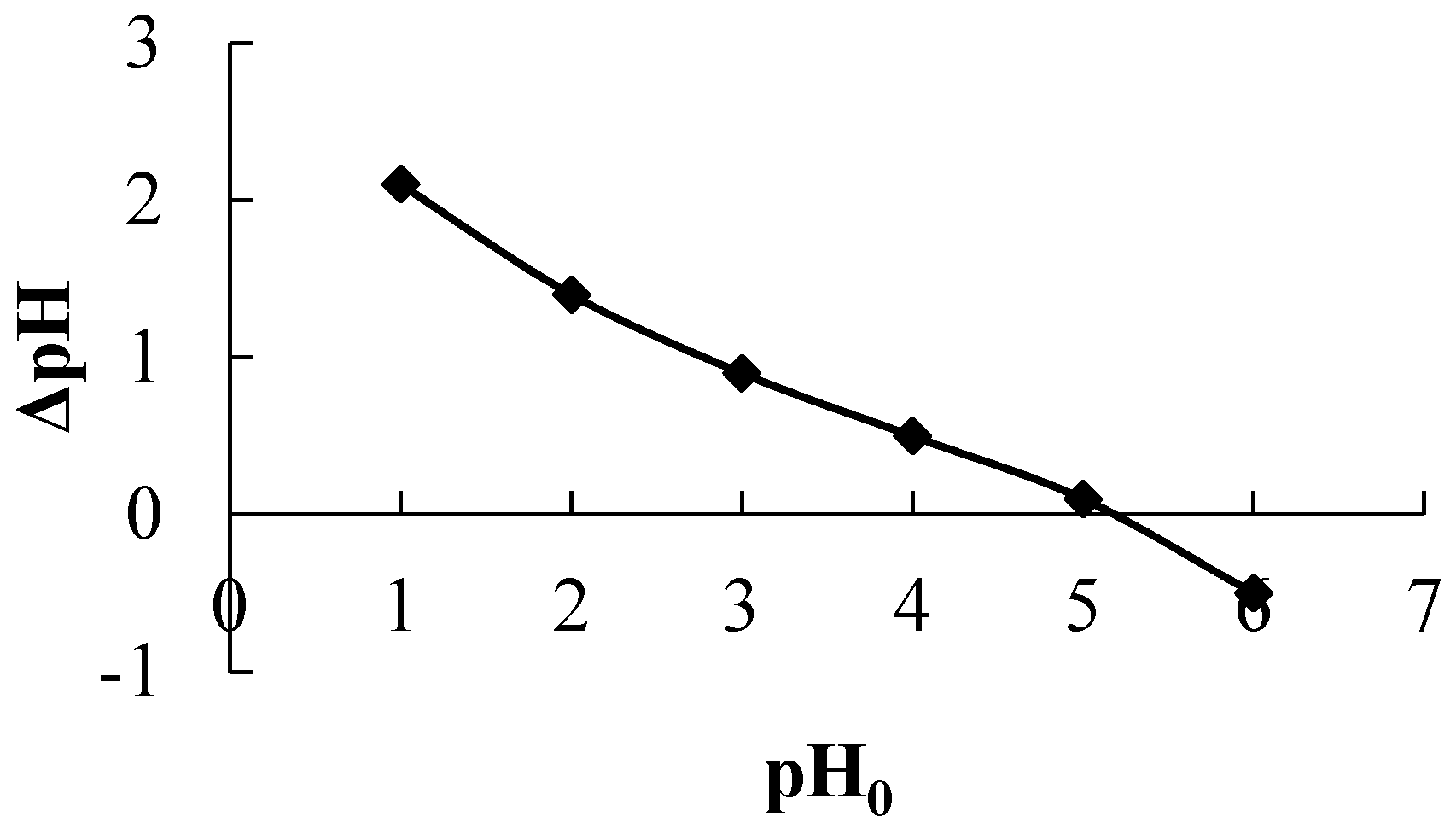
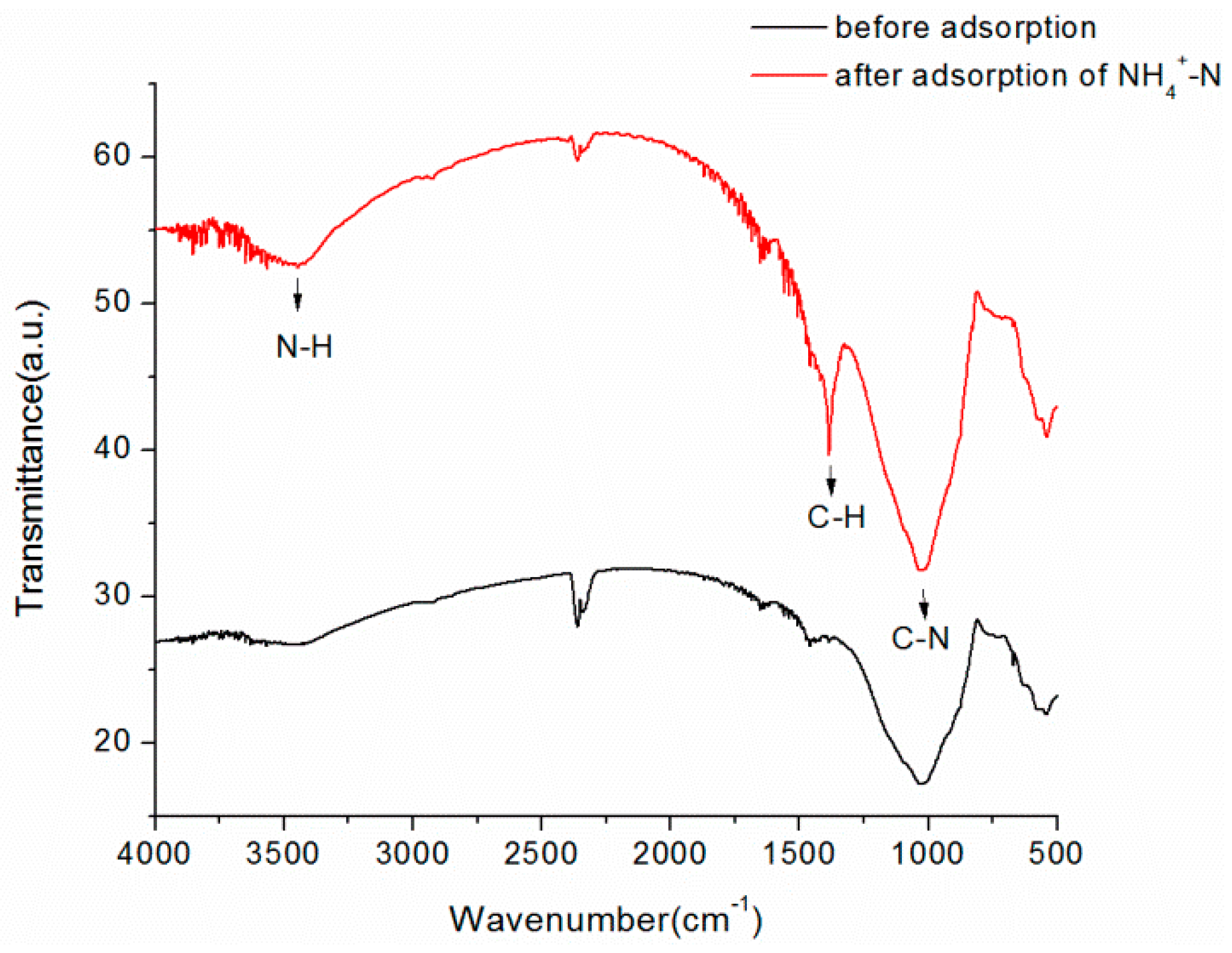
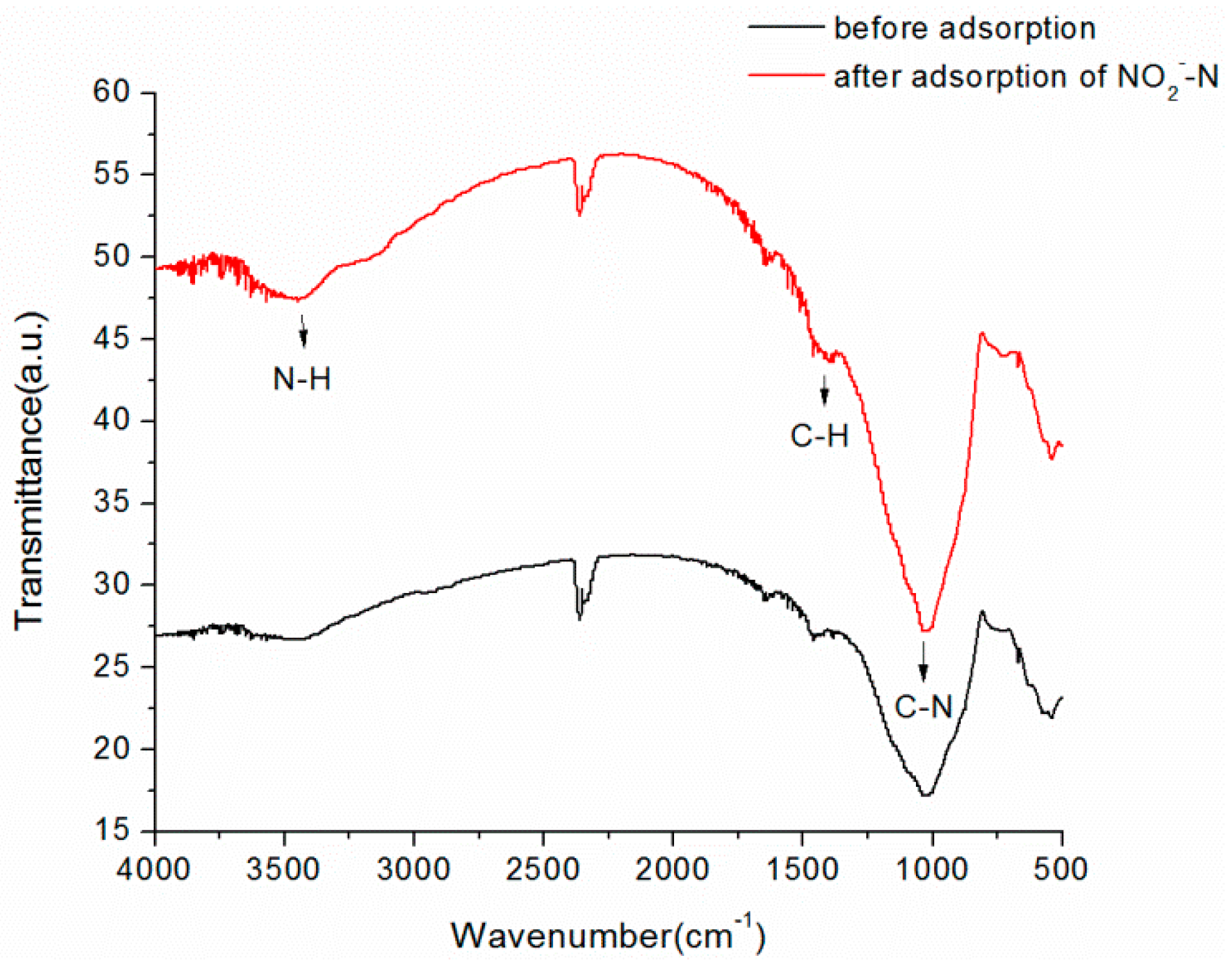
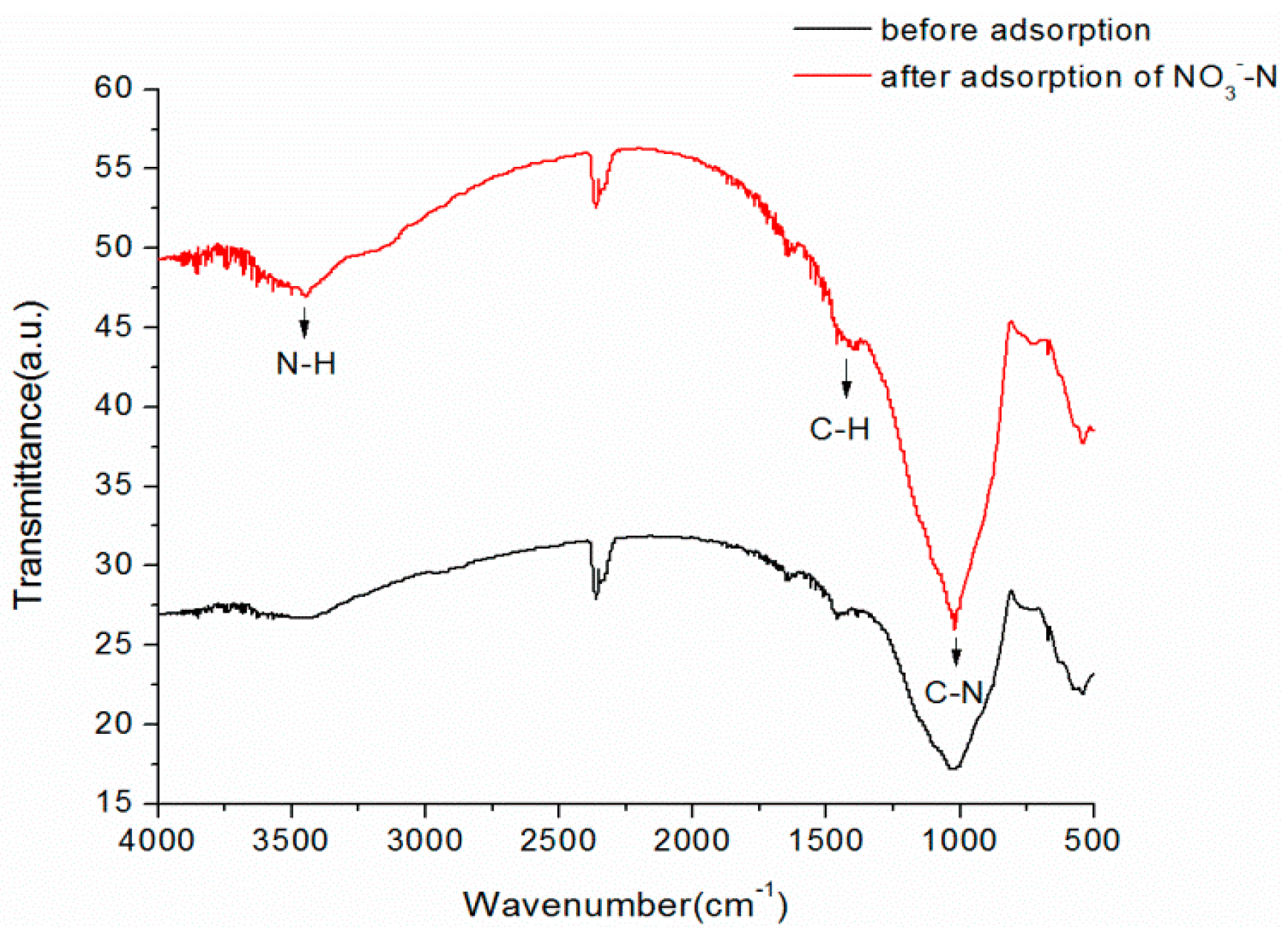
| Parameter | Value | Parameter | Value |
|---|---|---|---|
| Loose bulk density | 500–600 kg/m3 | BET specific surface area | 30–150 m2/g |
| Specific gravity | 2.4–2.6 | Apparent specific gravity | 1.4–1.6 |
| Closed porosity | 10–15% | Non-uniform coefficient | 1.4–1.6 |
| Total porosity | 74–78% | Open porosity | 60–70% |
| Element | Weight Percentage | Atomic Percentage | Compound Percentage |
|---|---|---|---|
| N (raw scoria) | 3.25 | 3.51 | 12.52 |
| N (after adsorbed NH4+-N) | 3.95 | 4.35 | 15.24 |
| N (after adsorbed NO2−-N) | 3.99 | 4.51 | 15.37 |
| N (after adsorbed NO3−-N) | 4.24 | 4.70 | 16.35 |
© 2017 by the authors. Licensee MDPI, Basel, Switzerland. This article is an open access article distributed under the terms and conditions of the Creative Commons Attribution (CC BY) license (http://creativecommons.org/licenses/by/4.0/).
Share and Cite
Dong, T.; Zhang, Y.; Su, X.; Chen, Z.; Si, C. Mechanism of Nitrogen Removal from Aqueous Solutions Using Natural Scoria. Water 2017, 9, 341. https://doi.org/10.3390/w9050341
Dong T, Zhang Y, Su X, Chen Z, Si C. Mechanism of Nitrogen Removal from Aqueous Solutions Using Natural Scoria. Water. 2017; 9(5):341. https://doi.org/10.3390/w9050341
Chicago/Turabian StyleDong, Tianzi, Yuling Zhang, Xiaosi Su, Zhiyu Chen, and Chaoqun Si. 2017. "Mechanism of Nitrogen Removal from Aqueous Solutions Using Natural Scoria" Water 9, no. 5: 341. https://doi.org/10.3390/w9050341





